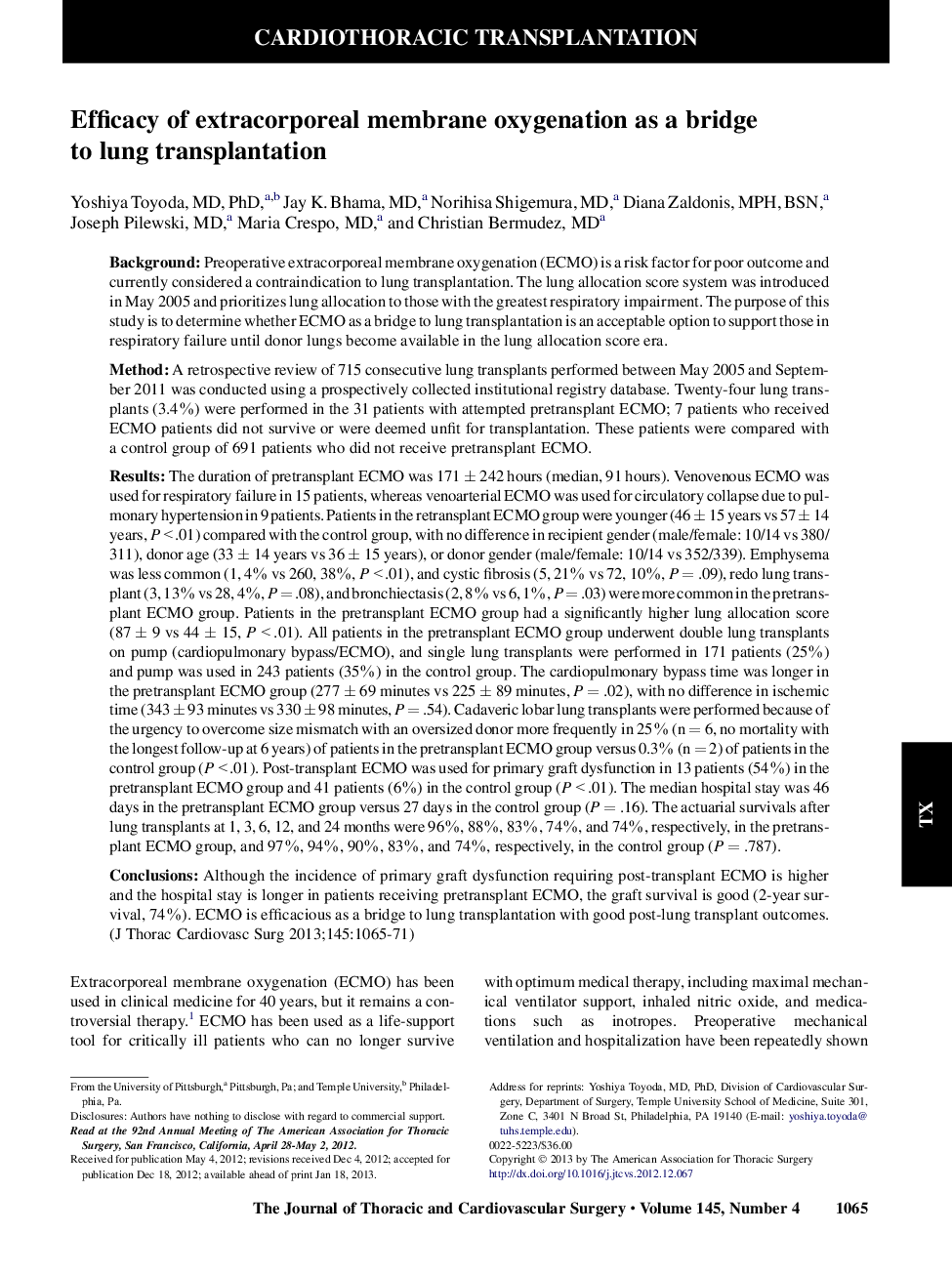| کد مقاله | کد نشریه | سال انتشار | مقاله انگلیسی | نسخه تمام متن |
|---|---|---|---|---|
| 5990013 | 1578624 | 2013 | 7 صفحه PDF | دانلود رایگان |
BackgroundPreoperative extracorporeal membrane oxygenation (ECMO) is a risk factor for poor outcome and currently considered a contraindication to lung transplantation. The lung allocation score system was introduced in May 2005 and prioritizes lung allocation to those with the greatest respiratory impairment. The purpose of this study is to determine whether ECMO as a bridge to lung transplantation is an acceptable option to support those in respiratory failure until donor lungs become available in the lung allocation score era.MethodA retrospective review of 715 consecutive lung transplants performed between May 2005 and September 2011 was conducted using a prospectively collected institutional registry database. Twenty-four lung transplants (3.4%) were performed in the 31 patients with attempted pretransplant ECMO; 7 patients who received ECMO patients did not survive or were deemed unfit for transplantation. These patients were compared with a control group of 691 patients who did not receive pretransplant ECMO.ResultsThe duration of pretransplant ECMO was 171 ± 242 hours (median, 91 hours). Venovenous ECMO was used for respiratory failure in 15 patients, whereas venoarterial ECMO was used for circulatory collapse due to pulmonary hypertension in 9 patients. Patients in the retransplant ECMO group were younger (46 ± 15 years vs 57 ± 14 years, P < .01) compared with the control group, with no difference in recipient gender (male/female: 10/14 vs 380/311), donor age (33 ± 14 years vs 36 ± 15 years), or donor gender (male/female: 10/14 vs 352/339). Emphysema was less common (1, 4% vs 260, 38%, P < .01), and cystic fibrosis (5, 21% vs 72, 10%, P = .09), redo lung transplant (3, 13% vs 28, 4%, P = .08), and bronchiectasis (2, 8% vs 6, 1%, P = .03) were more common in the pretransplant ECMO group. Patients in the pretransplant ECMO group had a significantly higher lung allocation score (87 ± 9 vs 44 ± 15, P < .01). All patients in the pretransplant ECMO group underwent double lung transplants on pump (cardiopulmonary bypass/ECMO), and single lung transplants were performed in 171 patients (25%) and pump was used in 243 patients (35%) in the control group. The cardiopulmonary bypass time was longer in the pretransplant ECMO group (277 ± 69 minutes vs 225 ± 89 minutes, P = .02), with no difference in ischemic time (343 ± 93 minutes vs 330 ± 98 minutes, P = .54). Cadaveric lobar lung transplants were performed because of the urgency to overcome size mismatch with an oversized donor more frequently in 25% (n = 6, no mortality with the longest follow-up at 6 years) of patients in the pretransplant ECMO group versus 0.3% (n = 2) of patients in the control group (P < .01). Post-transplant ECMO was used for primary graft dysfunction in 13 patients (54%) in the pretransplant ECMO group and 41 patients (6%) in the control group (P < .01). The median hospital stay was 46 days in the pretransplant ECMO group versus 27 days in the control group (P = .16). The actuarial survivals after lung transplants at 1, 3, 6, 12, and 24 months were 96%, 88%, 83%, 74%, and 74%, respectively, in the pretransplant ECMO group, and 97%, 94%, 90%, 83%, and 74%, respectively, in the control group (P = .787).ConclusionsAlthough the incidence of primary graft dysfunction requiring post-transplant ECMO is higher and the hospital stay is longer in patients receiving pretransplant ECMO, the graft survival is good (2-year survival, 74%). ECMO is efficacious as a bridge to lung transplantation with good post-lung transplant outcomes.
Journal: The Journal of Thoracic and Cardiovascular Surgery - Volume 145, Issue 4, April 2013, Pages 1065-1071
